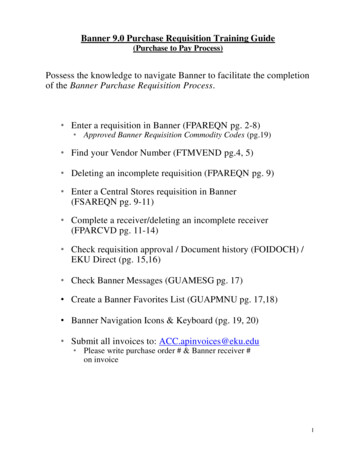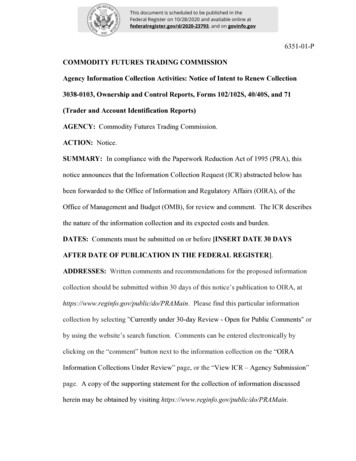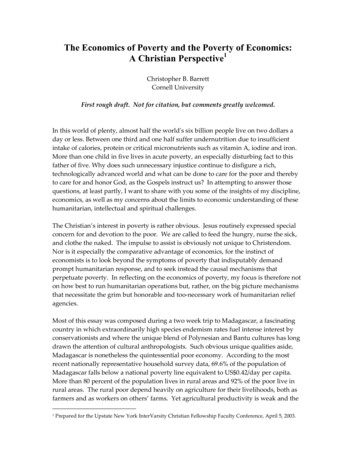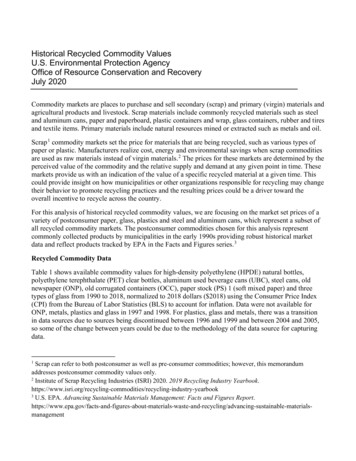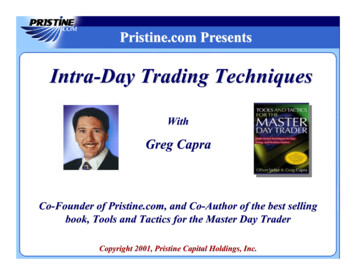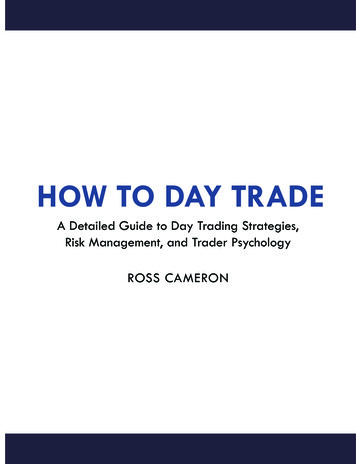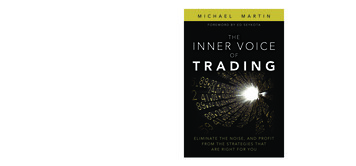
Transcription
THE ECONOMICSOF COMMODITYTRADING FIRMSCRAIG PIRRONGProfessor of FinanceBauer College of BusinessUniversity of Houston
TABLE OF CONTENTSABOUT THE AUTHORCRAIG PIRRONG is a professor of finance and the Energy Markets Director for the GlobalEnergy Management Institute at the Bauer College of Business at the University of Houston.Pirrong previously was the Watson Family Professor of Commodity and Financial RiskManagement and associate professor of finance at Oklahoma State University. He has alsoserved on the faculty of the University of Michigan Business School, Graduate School ofBusiness of the University of Chicago, and Olin School of Business of Washington Universityin St. Louis. He holds a Ph.D. in business economics from the University of Chicago.Pirrong’s research focuses on the economics of commodity markets, the relation betweenmarket fundamentals and commodity price dynamics, and the implications of this relationfor the pricing of commodity derivatives. He has also published substantial research onthe economics, law, and public policy of market manipulation. Pirrong also has writtenextensively on the economics of financial exchanges and the organization of financialmarkets, and most recently on the economics of central counterparty clearing of derivatives.He has published over thirty articles in professional publications and is the author of fourbooks. Pirrong has consulted widely, and his clients have included electric utilities, majorcommodity traders, processors, and consumers, and commodity exchanges around the world.INTRODUCTION4ITHE BASICS OF COMMODITY TRADINGA Commodity TransformationsB Value Creation in Commodity TradingC Commodity Trading Firms6679IITHE RISKS OF COMMODITY TRADINGA Risk CategoriesB Risk Management121217IIIRISK MANAGEMENT BY COMMODITY TRADING FIRMSA IntroductionB The Risk Management ProcessC Managing Flat Price Risk and Basis RiskD Risk MeasurementE Managing Credit RiskF Managing Liquidity RiskG Managing Freight RiskH Managing Other RisksI Paper Trading21212222242728282829IVCOMMODITY FIRM FINANCING,CAPITAL STRUCTURE, AND OWNERSHIPA The Financing of Commodity Trading FirmsB The Liability Structures of Commodity Trading FirmsC The Ownership of Commodity Trading Firms: Public vs. PrivateD Commodity Trading Firms as Financial Intermediaries3131333436VCOMMODITY FIRM ASSET OWNERSHIPAND VERTICAL INTEGRATIONA The Physical Asset Intensity of Commodity Trading FirmsB Asset Ownership by Commodity Trading Firms404042VISYSTEMIC RISK AND COMMODITY TRADING:ARE COMMODITY TRADING FIRMS TOO BIG TO FAIL?A IntroductionB Analysis of the Systemic Risk of Commodity Trading Firms494950AFTERWORD58APPENDIX ASource Data For International Trade Flow in Commodities60APPENDIX BTrading Activity and Physical Asset Ownership for Leading CommodityTrading Firms62CRAIG PIRRONGProfessor of FinanceTrafigura provided financial support for this research. I also benefited substantially from discussions withTrafigura management, traders, and staff. All opinions and conclusions expressed are exclusively mine,and I am responsible for all errors and omissions.Throughout this document “ ” refers to USD. Craig Pirrong, March 2014. All rights reserved.23
INTRODUCTIONINTRODUCTIONThe trading of the basic commodities that are transformed into thefoods we eat, the energy that f uels our transportation and heatsand lights our homes, and the metals that are present in the myriadobjects we employ in our daily lives is one of the oldest forms ofeconomic activity. Yet, even though this activity traces its originsinto prehistory, commodity trading is often widely misunderstood,and, as a consequence, it is often the subject of controversy. So tooBSF UIF «SNT UIBU FOHBHF JO JU This whitepaper is intended to help demystify the commodity tradingbusiness. It presents a combination of description and analysis:in it, I describe some salient features of the commodity tradingbusiness and commodity trading firms, and utilize a varietyof economic concepts to analyze and explain them.SUMMARY CONCLUSIONSSeveral fundamental conclusions flow from the analysis: Commodity trading firms exhibit considerable diversity in their investments in physicalassets, with some firms being relatively asset intensive, and others being very asset light.These firms also exhibit diverse trends in asset intensity. Within both categories (assetheavy and asset light), some firms are becoming more asset intensive, and others less(or remaining relatively constant). What economists refer to as “transactions costs economics” provides considerable insighton what kinds of assets commodity traders own, and why these ownership and investmentpatterns have changed over time. Most notably, these transactions costs economicsconsiderations imply that commodity traders have strong reasons to own “midstream”assets including storage facilities and terminals. Changes in commodity trading patternsin the last decade have created needs for increased investments in such midstream assets,and commodity trading firms have responded by building them. Although it has been suggested that commodity trading firms are potential sources ofsystemic risk, as are banks, and hence should be regulated in ways similar to banks, theyare in fact unlikely to be a source of systemic risk. That is, commodity trading firms are nottoo big to fail. Not only are they substantially smaller than truly systemically risky financialinstitutions, they do not engage in the kinds of maturity transformations that make banksvulnerable to runs; nor are they highly leveraged; nor are they major sources of credit;and the assets of a firm that experiences financial distress can be transferred to others.THE REMAINDER OF THIS PAPER IS ORGANIZED AS FOLLOWS:Section I discusses the basics of commodity trading, focusing on the three majortransformations that commodity traders undertake. Commodity trading firms are all essentially in the business of transforming commoditiesin space (logistics), in time (storage), and in form (processing). Their basic function is toperform physical “arbitrages” which enhance value through these various transformations.Section II summarizes the various risks that commodity trading firms face. Although all commodity traders engage in transformation activities, they are tremendouslydiverse. They vary in size, the commodities they trade and transform, the types oftransformations they undertake, their financing, and their form of ownership.Section IV examines the financing of commodity trading firms, their ownership structure,and their provision of funding to their customers. In engaging in these transformation activities, commodity traders face a wide array of risks,some of which can be managed by hedging, insurance, or diversification, but face othersthat must be borne by the firms’ owners.Section V analyzes asset ownership by commodity firms. Crucially, most commodity trading firms do not speculate on movements in the levelsof commodity prices. Instead, as a rule they hedge these “flat price” risks, and bear risksrelated to price differences and spreads—basis risks.The paper concludes with a brief afterword.Section III describes the risk management process at Trafigura.Section VI examines the question of whether commodity trading firms pose systemic risks. Risk management is an integral part of the operations of commodity trading firms. Somemajor risks are transferred to the financial markets, through hedging in derivatives or thepurchase of insurance. Other risks are mitigated by diversification across commoditiestraded, and across the kinds of transformations that firms undertake. Remaining risks areborne by equity holders, and controlled by policies, procedures, and managerial oversight. Commodity trading firms utilize a variety of means to fund their transformation activities.Different commodity traders use different funding strategies involving different mixes oftypes of debt and debt maturities, and these funding strategies are aligned with the typesof transformations firms undertake, and the types of assets they use to undertake them.Short-term assets like inventories are funded with short-term debt, and long-term assetsare funded with longer-term debt. Commodity trading firms provide various forms of financing and risk management servicesto their customers. Sometimes commodity marketing, financing, and risk managementservices are bundled in structured transactions with commodity trading firms’ customers.Offering these services to customers exploits trading firms’ expertise in merchandising andrisk management, utilizes the information commodity trading firms have, and providesbetter incentives to customers. Some commodity trading firms are public companies, whereas some are private.The private ownership model is well-adapted to traditional, “asset light” transformationactivities, but as economic forces are leading to increasing investments in physical assetsby all types of trading firms, the private ownership model is coming under pressure.Some major traders have already gone public; others are considering it; and still others areimplementing hybrid strategies that allow them to retain some of the benefits of privateownership while tapping the public capital markets (sometimes including the equitymarkets) to fund some investments.45
SECTION II. THE BASICS OF COMMODITY TRADINGSUMMARYAgricultural, energy and industrial commodities undergo a variety of processes to transformthem into things we can consume. These can be categorized as transformations in space,time, and form.Commodity trading firms (CTFs) add value by identifying and optimizing transformationsin commodities that reconcile mismatches between supply and demand: in space - using logistics in time - through storage in form - with processing.Physical and regulatory bottlenecks may act as constraints on these transformations.CTFs undertake physical arbitrage activities, which involve the simultaneous purchaseand sale of a commodity in different forms.CTFs do not speculate on outright commodity price risk, but aim to profit on the differentialbetween the untransformed and transformed commodity.CTFs specialize in the production and analysis of information that identifies optimaltransformations. They respond to price signals and invest in physical and human capitalto perform these transformations.There are many different types of CTF. They vary by size and by product specialization.Some are independent entities; others are subsidiaries of oil majors or banks. They maybe privately owned or publicly listed.A. COMMODITY TRANSFORMATIONSCommodities undergotransformations.in space through logisticsand transportation.in time.through storage.6Virtually all agricultural, energy, and industrial commodities must undergo a varietyof processes to transform them into things that we can actually consume. Thesetransformations can be roughly grouped into three categories: transformations in space,transformations in time, and transformations in form.Spatial transformations involve the transportation of commodities from regions wherethey are produced (supply regions) to the places they are consumed. The resources wherecommodities can be efficiently produced, such as fertile land or mineral deposits, are almostalways located away from, and often far away from, the locations where those who desireto consume them reside. Transportation—transformation in space—is necessary to bringcommodities from where they are produced to where they are consumed.Just as the locations of commodity production and consumption typically do not align,the timing of commodity production and consumption is often disjoint as well. This is mostreadily seen for agricultural commodities, which are often produced periodically (with a cropbeing harvested once a year for some commodities) but which are consumed continuouslythroughout the year. But temporal mismatches in production and consumption are notlimited to seasonally produced agricultural products. Many commodities are produced ata relatively constant rate through time, but are subject to random fluctuations in demanddue to a variety of factors. For instance, wells produce natural gas at a relatively steady rateover time, but there can be extreme fluctuations in the demand to consume gas due torandom changes in the weather, with demand spiking during cold snaps and falling whenwinter weather turns unseasonably warm. Commodity demand can also fluctuate dueto macroeconomic events, such as a financial crisis that causes economic activity to slow.Supply can also experience random changes, due to, for instance, a strike at a copper mine,or a hurricane that disrupts oil and gas production in the Gulf of Mexico.These mismatches in the timing of production and consumption create a need to engagein temporal transformations, namely, the storage of commodities. Inventories can beaccumulated when supply is unusually high or demand is unusually low, and can be drawndown upon when supply is unusually low or demand is unusually high. Storage is a wayof smoothing out the effects of these shocks on prices, consumption, and production.Furthermore, the other transformations (in space and form) require time to complete.Thus, commodity trading inevitably involves a financing element.Moreover, commodities often must undergo transformations in form to be suitable for finalconsumption, or for use as an input in a process further down the value chain. Soybeansmust be crushed to produce oil and meal that can be consumed, or serves as the input foryet additional transformations, as when the meal is fed to livestock or the oil is used as aningredient in a snack. Crude oil must be refined into gasoline, diesel, and other products that canbe used as fuels. Though often overlooked, blending and mixing are important transformationsin form. Consumers of a commodity (e.g., a copper smelter that uses copper concentrates asan input) frequently desire that it possess a particular combination of characteristics that mayrequire the mixing or blending of different streams or lots of the commodity.in form .through processingMost commodities undergo multiple transformations of all three types between the farm,plantation, mine or well, and the final consumer. Commodity trading firms are vital agentsin this transformation process.B. VALUE CREATION IN COMMODITY TRADINGCommodity trading is, in essence, the process of transforming commodities in space, time,and form. Firms that engage in commodities trading attempt to identify the most valuabletransformations, undertake the transactions necessary to make these transformations, andengage in the physical and operational actions necessary to carry them out. The creationof value in commodities trading involves optimizing these transformations.Commodity tradersaim to optimizetransformationsThis is an inherently dynamic process because the values of the myriad possible transformationsvary over time due to shocks to supply and demand. For instance, a good harvest ofa commodity in one region will typically make it optimal to store additional quantitiesof that commodity, and to transport the additional output to consumption locations.Developments in oil markets in North America illustrate how dynamic transformationopportunities can be. Prior to the dramatic increases in oil production in places like theBakken, the Permian Basin, and the Eagle Ford, the Midcontinent of the United Stateswas a deficit production region where the marginal barrel was imported to the GulfCoast and transported to the Midcontinent via pipeline to supply refineries in theregion. The unprecedented rise in oil output turned this situation on its head. Soon theMidconcontinent became an area of supply surplus. This necessitated an increase instorage in the region, and a reversal of transportation patterns. There have also beenknock-on effects, including the virtual elimination of light sweet crude imports into theUnited States and the redirection of Nigerian crude (for instance) to other markets. That is,a supply shock led to a complete change in the optimal pattern of transformation not justin the US, but around the world.The process of making transformations is constrained by technology and availableinfrastructure. For instance, transportation technology and resources—ocean freight, rail,barge, truck, pipelines—determine the set of possible spatial transformations. Similarly,storage capacity determines the feasible intertemporal transformations.Constraints on transformation possibilities can vary in severity over time. Severe constraintsrepresent “bottlenecks”. One important function of commodity traders is to identify thesebottlenecks, and to find ways to circumvent them. This can be achieved by finding alternativeways to make the transformation, and/or investing in additional infrastructure that alleviatesthe constraints. Developments in the North American oil market also illustrate theseprocesses. The lack of pipelines capable of transporting oil from the Midcontinent andother regions in which production had spiked to refineries on the Gulf was a bottleneck thatseverely constrained the ability to move oil from where it was abundant to where it wasscarce. In the short run, traders identified and utilized alternative means of transportation,including truck, barge and rail. Over a slightly longer time frame some existing pipelines werereversed and new pipelines were built. Within a period of roughly two years, the bottleneckhad largely been eliminated.They overcomebottlenecks.Sometimes bottlenecks are not physical, but are instead the consequence of regulatory orlegal restrictions. At present, the primary bottleneck that is impeding the movement of newlyabundant North American crude to markets where it is scarcer is the US law that largely prohibitsthe export of crude oil. Even there, traders are finding ways to alleviate the constraint. Forinstance, market participants are investing in “splitters” (“mini-refineries”) that transform crudeoil that cannot be exported, into refined products that can be sold abroad.7
SECTION Iand incurtransportation,storage, andprocessing costs.The primary role of commodity trading firms is to identify and optimize those transformations.An important determinant of the optimization process is the cost of making the transformations.These costs include transportation costs (for making spatial transformations), storage costs(including the cost of financing inventory), and processing/refining costs. These costs depend,in part, on constraints/bottlenecks in the transformation processes. All else equal, the tighterthe constraints affecting a particular transformation process, the more expensive thattransformation is.to realizephysical arbitrageCommodity traders characterize their role as finding and exploiting “arbitrages”. An arbitrageis said to exist when the value of a transformation, as indicated by the difference betweenthe prices of the transformed and untransformed commodity, exceeds the cost of making thetransformation.1Consider a spatial transformation in grain. A firm can buy corn in Iowa for 5.00/bushel (bu)and finds a buyer in Taiwan willing to pay 6.25/bu. Making this transaction requires a traderto pay for elevations to load the corn on a barge, and from a barge to an oceangoing ship;to pay barge and ocean freight; to finance the cargo during its time in transit; and to insurethe cargo against loss. The trader determines that these costs total 1.15/bu, leaving a marginof 0.10/bu. If this is sufficient to compensate for the risks and administrative costsincidental to the trade, the trader will make it.This description of a typical commodity trade illustrates that the commodity traders areprimarily concerned with price differentials, rather than the absolute level of commodityprices. Traders buy and sell physical commodities. The profitability of these activities dependson the difference between the prices of the transformed and untransformed commodities,rather than their level. As will be discussed in more detail subsequently, price levels affect theprofitability of commodity trading primarily through their effect on the cost of financingtransactions, and their association with the volume of transactions that are undertaken.They tradeface-to-face withbuyers and sellersAlthough commodity trading firms use centralized auction markets (e.g., futures markets)primarily to manage price risks, their core activities of buying, selling, and transformingphysical commodities takes place in what economists call bilateral “search” markets.Commodity trading firms search to identify potential sellers and potential buyers, andengage in bilateral face-to-face transactions with them.This reflects the facts that auction trading on central markets is an efficient way to transacthighly standardized instruments in large quantity, but is not well-adapted to trading thingsas diverse as physical commodities. Even a particular commodity—say corn, or crudeoil—is extraordinarily diverse, in terms of location (of both producers and consumers) andphysical characteristics. Moreover, consumers and producers often have highly idiosyncraticpreferences. For instance, oil refineries are optimized to process particular types of crude oil,and different refineries are optimized differently. The trade of diverse physical commoditiesrequires matching numerous producers and consumers with heterogeneous preferences.Centralized markets are not suited to this matching process. Instead, since time immemorial,traders have searched both sides of the market to find sellers and buyers, and matched themby buying from the former and selling to the latter in bilateral transactions, and added valueby engaging in transformations.They invest ininformation systems and in human andphysical resourcesTo operate in these markets, commodity trading firms specialize in (1) the production andanalysis of information buyers and sellers active in the market, supply and demand patterns,price structures (over space, time, and form), and transformation technologies, and (2) theutilization of this information to optimize transformations. In essence, commodity traders arethe visible manifestation of the invisible hand, directing resources to their highest value usesin response to price signals. Given the complexity of the possible transformations, and theever-changing conditions that affect the efficient set of transformations, this is an inherentlydynamic, complex, and highly information-intensive task.Trading firms also invest in the physical and human capital necessary to transform commodities.Commodity trading therefore involves the combination of the complementary activitiesof information gathering and analysis and the operational capabilities necessary to respondefficiently to this information by transforming commodities to maximize their value.1 This use of the term “arbitrage” is contrary to the strict academic usage in finance, i.e., a transaction that earns apositive profit with positive probability, but entails no risk of loss. Virtually all of the commodity trades referred toas “arbitrages” involve some risk of loss. The use of the term is therefore aspirational. It indicates that traders areattempting to identify and implement very low risk trades, and in particular, trades that are not at risk to changesin the general level of a commodity’s price.8Value creation opportunities in commodity trading depend on the economic environment.Volatile economic conditions increase value creation opportunities. Supply and demandshocks can cause geographic imbalances that create spatial arbitrage opportunities fortraders. Greater volatility also makes storage more valuable, thereby creating intertemporalarbitrage opportunities. Greater economic volatility is also associated with greater volatilityin relative prices, and in particular in temporary mispricings that create trading opportunities.Moreover, major secular economic shifts can create imbalances that drive trade and increasearbitrage opportunities. The dramatic growth of China in the past 20 years, and particularlyin the last decade, is an example of this.These factors explain why the profitability of commodity trading has tended to be greatestduring periods of economic volatility, such as the Iranian Revolution, the Gulf War, and thecollapse of the Soviet Union, and during periods of rapid growth concentrated in a particularcountry or region.They are moreQSP«UBCMF EVSJOH periods of upheavalIn summary, commodity trading firms are in the business of making transformations.In doing so, they respond to price signals to move commodities to their highest value uses.This improves the efficiency of resource allocation. Indeed, as Adam Smith noted centuriesago, making these transformations more efficiently can be a matter of life and death. 2C. COMMODITY TRADING FIRMSA large and diverse set of firms engages in commodity trading.3 Indeed, the diversity is soextensive, and occurs along so many dimensions, that it is difficult to make generalizations.Some commodity trading firms are stand-alone entities that specialize in that activity.For instance, well-known trading firms such as Trafigura and Vitol are independent andengage almost exclusively in commodity transformation activities.Other commodity traders are subsidiaries or affiliates of other kinds of firms.For instance, many banks have (or had) commodity trading operations. Prominent examplesinclude J. Aron (part of Goldman Sachs since 1981), Phibro (once part of Citigroup and beforethat Salomon Brothers, though it is now not affiliated with a bank), and the commoditytrading divisions of Morgan Stanley, J. P. Morgan Chase, and Barclays (to name some of themost prominent).Other commodity trading entities are affiliated with larger industrial enterprises. Mostnotably, many “supermajor” oil companies (such as Shell, BP, and Total) have large energytrading operations (though some, notably Exxon, do not). Pipeline and storage operators(“midstream” firms such as Kinder Morgan and ETP in the United States) in energy oftenengage in trading as well.Commodity trading firms also differ by the breadth of the commodities they trade. Someare relatively specialized, trading one or a few commodities. Others trade a broader set ofcommodities but within a particular sector. For instance, the traditional “ABCD” firms-ADM,Bunge, Cargill, and Louis Dreyfus-concentrate in agricultural commodities, with lesser or noinvolvement in the other major commodity segments (although Cargill does have a sizableenergy trading operation). As another example, some of the largest trading firms such asVitol, and Mercuria, and the energy trading-affiliates of the oil supermajors, focus on energycommodities, with smaller or no presence in other commodity segments. One major tradingfirm, Glencore, participates in all major commodity segments, but has a stronger presencein non-ferrous metals, coal, and oil. Another, Trafigura, is a major energy and non-ferrousmetals trader.Commodity trading«SNT WBSZ CZ scope and scale.Firms with a presence in a particular sector (e.g., agriculture) also vary in the diversity ofcommodities they trade. For instance, whereas Olam participates in 18 distinct agriculturalsegments, Bunge focuses on two and other major firms are active in between three andseven different segments.2 Adam Smith, The Wealth of Nations (1776). In Chapter V of Book IV, titled “Digression Concerning the Corn Trade andCorn Laws,“ Smith describes how by engaging in transformations in space and transformations in time grain traders(“corn dealers”) were invaluable in preventing local shortages from causing famines. He further noted that eventhough traders perform their most valuable service precisely when supplies are short and prices high, this is also whenthey are subject to the heaviest criticism.3 I will use the term “commodity trading” to mean the process of purchasing, selling, and transforming physicalcommodities.9
SECTION Ithey may own assetsupstream, midstreamor downstream.Furthermore, firms in a particular segment differ in their involvement along the marketingchain. Some firms participate upstream (e.g., mineral production or land/farm ownership),midstream (e.g., transportation and storage), and downstream (e.g., processing into finalproducts or even retailing). Others concentrate on a subset of links in the marketing chain.(This is discussed in more detail in Section V.)Commodity trading firms also vary substantially in size. There are large numbers of smallfirms that tend to trade a single commodity and have revenues in the millions of dollars.At the other end of the spectrum, the largest traders participate in many markets and haverevenues well over 100 billion.they can beprivately ownedor publicly listed10Firms that engage in commodity trading also exhibit diverse organizational forms. Some,including many of the most prominent (Cargill, Louis Dreyfus, Koch Industries) are privatelyowned. Some of these non-public traders are funded by private equity investors: TrailStone(Riverstone Holdings) and Freepoint Commodities (Stone Point Capital) are well-knownexamples. Others (e.g., ADM and Bunge) are publicly traded corporations. Some are affiliatesor subsidiaries of publicly traded firms. Yet others are organized as master limitedpartnerships with interests traded on stock exchanges: Kinder Morgan, ETP, and PlainsAll American are examples of this.11
SECTION IIII. THE RISKS OF COMMODITY TRADINGtransforms the exposure to the commodity’s flat price into an exposure to the basis betweenthe price of the commodity and the price of the hedging instrument. (I discuss basis risk inmore detail below).SUMMARYOf course, hedging is
books. Pirrong has consulted widely, and his clients have included electric utilities, major . Commodity trading firms utilize a variety of means to fund their transformation activities. . others are subsidiaries of oil majors


